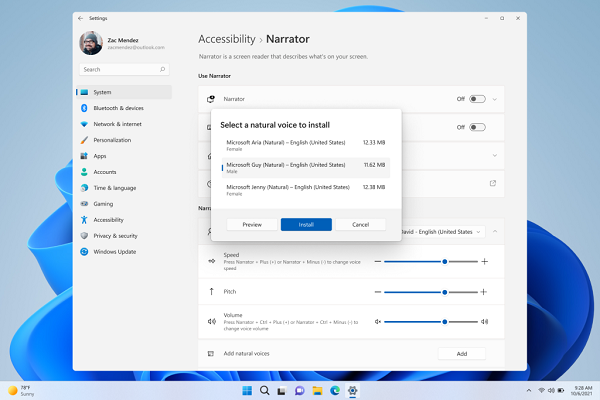Microsoft Windows 11 Introduces New Narrator Voices and Live Captions
 Microsoft’s new Windows 11 operating system has upgraded and expanded some of it voice AI capabilities to improve its accessibility. Windows 11 includes several new , more natural-sounding voices for its Narrator text-to-speech AI, as well as a comprehensive live captions feature to transcribe conversations in real time.
Microsoft’s new Windows 11 operating system has upgraded and expanded some of it voice AI capabilities to improve its accessibility. Windows 11 includes several new , more natural-sounding voices for its Narrator text-to-speech AI, as well as a comprehensive live captions feature to transcribe conversations in real time.
Narration and Captions
The most notable new voice accessibility feature comes in the form of a collection of AI voice models for the Windows Narrator tool. Narrator acts as an AI-powered reader for everything on the screen, including websites, documents, and any other text. The four new models were built to sound more like a human being so that they willl not become irritating or disorienting to listen to and thus make using Windows easier for those with impaired sight.
“As a screen reader user myself, I truly understood the need for some changes to Narrator’s voice. Listening to that voice all day while working, reading an article or book, or just surfing the web on the sofa – it needs to be a delightful experience,” Narrator product manager Jeff Bishop explained. “To develop the new natural sounding voices for Narrator – “Aria,” “Guy” and “Jenny” – we had to figure out what made a voice “great” for a screen reader user. I spent considerable time with our engineering team to improve responsiveness and other characteristics of the voices, and we tested and gathered tons of feedback to ensure they met my needs as a user and for the needs of all screen reader users around the world.”
The new captions feature works in reverse of the Narrator function, turning spoken words into text. Once activated, any conversation held through Windows gets typed out by an AI in a floating window at the top of the screen. There are more voice AI aspects of Windows 11 are still in development, according to Microsoft. The system is running a beta test of a new Voice Access feature that would enable users to control their PC by voice commands. That includes rearranging text, controlling apps, and even moving a cursor around without the need for a keyboard or mouse. Microsoft’s pursuit of better accessibility tools fits into the larger trend of tech companies employing voice AI and related technology to make their devices more accessible, including the recent editions of Amazon’s Fire tablets and Apple adding live captions to iPhones.
Follow @voicebotaiFollow @erichschwartz
OpenAI Releases Open-Source ‘Whisper’ Transcription and Translation AI
Amazon’s New Fire HD 8 Tablets Add ‘Tap to Alexa’ Buttons for Voice Assistant Tasks
Apple Debuts Siri Pause Time, iPhone Live Captions in Slate of New Accessibility Tools








